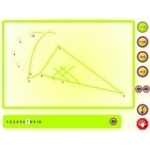
 |
Dot To Dot |
Children love dot-to-dot games. They have lots of fun whilst developing their knowledge of letter and number sequences.
In this game there are four groups of puzzles to solve:
Children can choose a puzzle group from the buttons on the right side toolbar. To start, click on the small circle next to the number 1, letter A or letter a. Continue by clicking on the next number or letter circle in the sequence. As the correct number or letter is selected, a line is drawn from the previous one.
The pointer will change from an arrow to a pointing finger when it is over a "hot-spot". This is an active area where something will happen when it is clicked.
The right pointing purple arrow in the bottom left corner of the screen is a help tool. When a number or letter is clicked, the next number or letter in the sequence will be highlighted. To increase the level of difficulty, close this option by clicking on the arrow pointing to the left. This help tool can be opened or closed at any time during the game.
When completed, a sound can be heard and the next puzzle will appear.
Back and forward facing arrows on the right toolbar can be clicked to scroll through the puzzles.
Puzzle groupings can be changed at any time.
Sound can be turned off and on by clicking the music symbol in the lower right hand corner.
To exit, click on the small hand in the lower right corner of the screen.
Outcome 4: Children are involved and confident learners
Outcome 5: Children are effective communicators
Number recognition and sequencing 1 to 20
Letter recognition and sequencing
Upper and lower case letters
Single click mouse control
Identifying hot-spots
Using a help option
Using arrows to scroll
Before starting each dot-to-dot ask the children to have a guess at what the picture might be. Some of them are a little tricky to guess. After every click see if the new line confirms your initial guess. See who can identify the object first.
With the advent of optical mouse technology many people now opt not to use a mouse pad. For preschoolers, we recommend that a mouse pad be used.
In the early stages of learning mouse control it is good for users to have a small, designated target area on which to use the mouse. This helps them to get used to repositioning the mouse when it starts to "get away" a little. Children will sometimes be so focused on the activity they are playing, they will often lose track of where the mouse is on the table. This can adversely affect their posture and mouse use. We have seen children having difficulty with the mouse and banging it on the table in frustration, not realizing that it won't work because it is nearly off the edge of the table or butted up against the keyboard. Some table surfaces may also affect the mouse function due to their shine/reflection or pattern.
Using a mouse pad can also assist children to understand what direction to move the mouse. Pretend the mouse pad is the screen. Moving to the top left of the mousepad is like moving to the top left of the screen, etc.